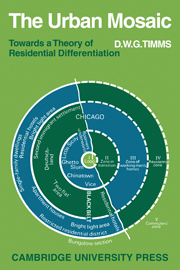Book contents
1 - The city as a mosaic of social worlds
Published online by Cambridge University Press: 05 January 2012
Summary
RESIDENTIAL DIFFERENTIATION
The urban community is neither an undifferentiated mass nor a haphazard collection of buildings and people. In the residential differentiation of the city the urban fabric comes to resemble a ‘mosaic of social worlds’. Similar populations cluster together and come to characterize their areas. As Park put it:
In the course of time every sector and quarter of the city takes on something of the character and qualities of its inhabitants. Each separate part of the city is inevitably stained with the peculiar sentiments of its population. The effect of this is to convert what was at first a mere geographical expression into a neighbourhood, that is to say, a locality with sentiments, traditions, and a history of its own.
The residential differentiation of the urban population takes place in terms of many attributes and in many ways. Almost any criterion which can be used for differentiating between individuals and groups may become the basis for their physical separation. The process of separation may be accomplished through force, through a variety of sanctions, through a voluntary aggregation designed as a defence against unfamiliar ideas or customs or as an escape from persecution and discrimination, and through a selection of market forces. In much early town planning residential differentiation and segregation appear as prime characteristics.
- Type
- Chapter
- Information
- The Urban MosaicTowards a Theory of Residential Differentiation, pp. 1 - 35Publisher: Cambridge University PressPrint publication year: 1971
- 1
- Cited by



